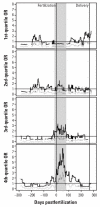Maternal residence near agricultural pesticide applications and autism spectrum disorders among children in the California Central Valley
- PMID: 17938740
- PMCID: PMC2022638
- DOI: 10.1289/ehp.10168
Maternal residence near agricultural pesticide applications and autism spectrum disorders among children in the California Central Valley
Abstract
Background: Ambient levels of pesticides ("pesticide drift") are detectable at residences near agricultural field sites.
Objective: Our goal was to evaluate the hypothesis that maternal residence near agricultural pesticide applications during key periods of gestation could be associated with the development of autism spectrum disorders (ASD) in children.
Methods: We identified 465 children with ASD born during 1996-1998 using the California Department of Developmental Services electronic files, and matched them by maternal date of last menstrual period to 6,975 live-born, normal-birth-weight, term infants as controls. We determined proximity to pesticide applications using California Department of Pesticide Regulation records refined using Department of Water Resources land use polygons. A staged analytic design applying a priori criteria to the results of conditional logistic regressions was employed to exclude associations likely due to multiple testing error.
Results: Of 249 unique hypotheses, four that described organochlorine pesticide applications--specifically those of dicofol and endosulfan--occurring during the period immediately before and concurrent with central nervous system embryogenesis (clinical weeks 1 through 8) met a priori criteria and were unlikely to be a result of multiple testing. Multivariate a posteriori models comparing children of mothers living within 500 m of field sites with the highest nonzero quartile of organochlorine poundage to those with mothers not living near field sites suggested an odds ratio for ASD of 6.1 (95% confidence interval, 2.4-15.3). ASD risk increased with the poundage of organochlorine applied and decreased with distance from field sites.
Conclusions: The association between residential proximity to organochlorine pesticide applications during gestation and ASD among children should be further studied.
Keywords: autism spectrum disorders; health surveillance; methods; organochlorines; pesticides.
Figures



Comment in
-
Autism and agricultural pesticides. Integrating data to track trends.Environ Health Perspect. 2007 Oct;115(10):A504. doi: 10.1289/ehp.115-a504a. Environ Health Perspect. 2007. PMID: 17938721 Free PMC article. No abstract available.
-
The interaction of agricultural pesticides and marginal iodine nutrition status as a cause of autism spectrum disorders.Environ Health Perspect. 2008 Apr;116(4):A155. doi: 10.1289/ehp.11010. Environ Health Perspect. 2008. PMID: 18414608 Free PMC article. No abstract available.
Similar articles
-
Neurodevelopmental disorders and prenatal residential proximity to agricultural pesticides: the CHARGE study.Environ Health Perspect. 2014 Oct;122(10):1103-9. doi: 10.1289/ehp.1307044. Epub 2014 Jan 23. Environ Health Perspect. 2014. PMID: 24954055 Free PMC article.
-
Prenatal and infant exposure to ambient pesticides and autism spectrum disorder in children: population based case-control study.BMJ. 2019 Mar 20;364:l962. doi: 10.1136/bmj.l962. BMJ. 2019. PMID: 30894343 Free PMC article.
-
Prenatal Organophosphate Pesticide Exposure and Traits Related to Autism Spectrum Disorders in a Population Living in Proximity to Agriculture.Environ Health Perspect. 2018 Apr 25;126(4):047012. doi: 10.1289/EHP2580. Environ Health Perspect. 2018. PMID: 29701446 Free PMC article.
-
Autism Spectrum Disorder and Prenatal or Early Life Exposure to Pesticides: A Short Review.Int J Environ Res Public Health. 2021 Oct 19;18(20):10991. doi: 10.3390/ijerph182010991. Int J Environ Res Public Health. 2021. PMID: 34682738 Free PMC article. Review.
-
A profile and review of findings from the Early Markers for Autism study: unique contributions from a population-based case-control study in California.Mol Autism. 2021 Mar 18;12(1):24. doi: 10.1186/s13229-021-00429-7. Mol Autism. 2021. PMID: 33736683 Free PMC article. Review.
Cited by
-
Enriched rearing improves behavioral responses of an animal model for CNV-based autistic-like traits.Hum Mol Genet. 2012 Jul 15;21(14):3083-96. doi: 10.1093/hmg/dds124. Epub 2012 Apr 5. Hum Mol Genet. 2012. PMID: 22492990 Free PMC article.
-
Home proximity to flower plantations and higher systolic blood pressure among children.Int J Hyg Environ Health. 2018 Sep;221(8):1077-1084. doi: 10.1016/j.ijheh.2018.08.006. Epub 2018 Aug 18. Int J Hyg Environ Health. 2018. PMID: 30131222 Free PMC article.
-
Autism spectrum disorders, endocrine disrupting compounds, and heavy metals in amniotic fluid: a case-control study.Mol Autism. 2019 Jan 9;10:1. doi: 10.1186/s13229-018-0253-1. eCollection 2019. Mol Autism. 2019. PMID: 30647876 Free PMC article.
-
Disproportionate exposures in environmental justice and other populations: the importance of outliers.Am J Public Health. 2011 Dec;101 Suppl 1(Suppl 1):S53-63. doi: 10.2105/AJPH.2011.300121. Epub 2011 May 6. Am J Public Health. 2011. PMID: 21551384 Free PMC article. Review.
-
Residential agricultural pesticide exposures and risks of preeclampsia.Environ Res. 2018 Jul;164:546-555. doi: 10.1016/j.envres.2018.03.020. Epub 2018 Mar 31. Environ Res. 2018. PMID: 29614386 Free PMC article.
References
-
- Agency for Toxic Substances and Disease Registry. Toxicological Profile for Endosulfan. Atlanta, GA: Agency for Toxic Substances and Disease Registry; 2000. - PubMed
-
- Akaike H. Information theory and an extension of the maximum likelihood principle. In: Petrov BN, Csaki F, editors. Second International Symposium on Information Theory. Budapest: Akademiai Kiado; 1973. pp. 267–281.
-
- Alexander G, Himes J, Kaufman R, Mor J, Kogan M. A United States national reference for fetal growth. Obstet Gynecol. 1996;87(2):163–168. - PubMed
-
- American Psychiatric Association. Diagnostic and Statistical Manual of Mental Disorders. 4. Washington, DC: American Psychiatric Publishing, Inc; 2000. text revision.
Publication types
MeSH terms
Substances
Grants and funding
LinkOut - more resources
Full Text Sources
Medical
Miscellaneous

